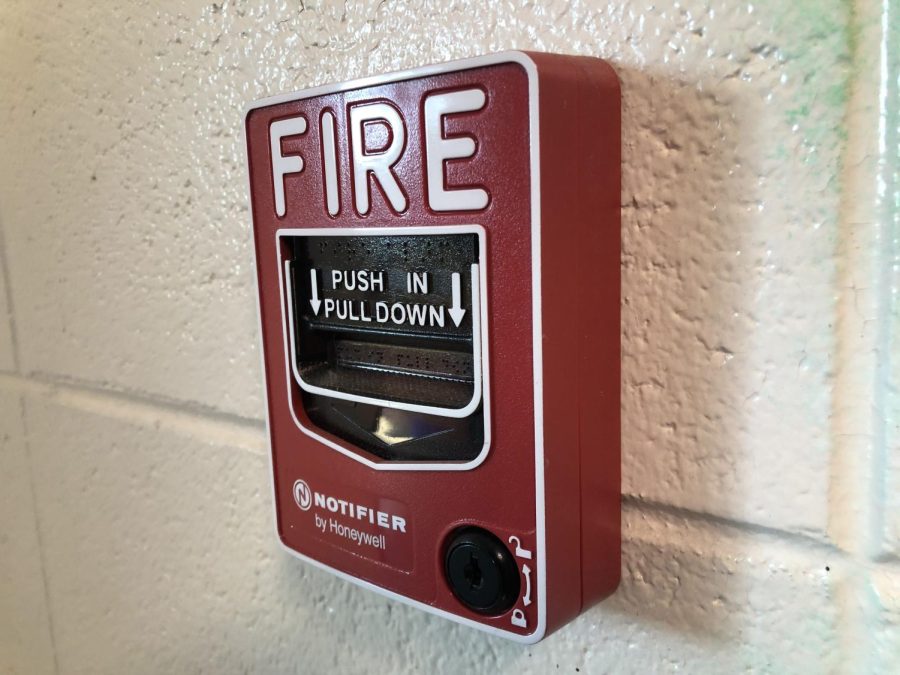Opinion: Rehearsing for the wrong disaster
Fire alarm mounted on a wall. Fire drills are practiced too often, while the more important lockdown drills are neglected.
It is an independent work day in AP Physics, and everyone has their nose to the grindstone to finish the assignment before the bell rings. This is the most challenging unit of the semester, and the work is piling up. I also have an away game tonight, and I can’t afford to have this for homework, so I pick up the pace.
Suddenly, my ears are blasted with a blaring din that is the school’s fire alarm. Startled by our work, my classmates and I push back our stools with a lot of screeching. We grab our phones from the pouches, complain, and a few of us even pack up before we head out the door. Class time is interrupted yet again. I chat with my classmates as we slowly make our way to the parking lot. Welcome to the monthly fire drill.
The frequency at which we practice fire drills is unnecessary and is adverse to maximizing learning during the school day. On the contrary, the emphasis needs to be on lockdown drills as the frequency and danger of school shootings increases throughout the nation.
“It’s a challenge to balance all the various things to potentially be prepared for,” Starr’s Mill Principal Allen Leonard said. “We could have a school where all we did was practice drills all day longー we would never get any education done. So that balance between making sure class time is protected, but also the safety things are protected, too, is one of the things we have to work on.”
Although the likelihood of a shooting occurring at any one school is very low, the threat one of these events poses to students is several magnitudes greater than that of any structural fire.
According to the National Fire Protection Association, the last school fire with ten or more deaths occurred in 1958, and between 2014 and 2018, there were over 3,000 structure fires resulting in only one civilian death per year.
A recent feature from U.S. News & World Report says that since the 1999 Columbine massacre, which was a catalyst for future attacks, 169 people have been murdered in U.S. school shootings. These numbers do not even include the attackers who followed up by committing suicide.
“There’s a fine line in between when you should do [lockdown drills] and when you shouldn’t do them in regards to how frequent we do them, because you have to weigh all options with practicing them,” assistant principal Shane Ratliff, who is in charge of school safety, said. “If they’re announced and the kids know about them, then that might be something we could continue doing. When kids don’t know about lockdowns, and we don’t announce it, the anxiety goes up.”
The high frequency of fire drills has led to complacency when the alarm rings, so that during the real thing, everybody would take much too long to evacuate. The priority when the alarm goes off is to grab phones from their pouches and gather school materials into backpacks, instead of evacuating.
In the event of a school shooting, efficiency on the victims’ part is crucial. Students and faculty need to find safety as soon as possible, and that can only happen if the situation has been practiced.
The urgency in the event of shooting is intensified because an active shooter is in search of human lives to take. On the other hand, the only thing flames seek is fuel to keep burning.
Because the event of an active shooter at a school is so perilous, informed lockdown drills need to happen more often. In contrast, the frequency at which fire drills are practiced is unnecessary and inefficient.
Opinions expressed in editorials are those of the writer(s). These views may not represent the adviser, The Prowler, advertisers/sponsors, the Starr’s Mill High School administration or staff , or Fayette County Public Schools as a whole. Please see our FAQs for more information pertaining to the rights of The Prowler’s staff members.


